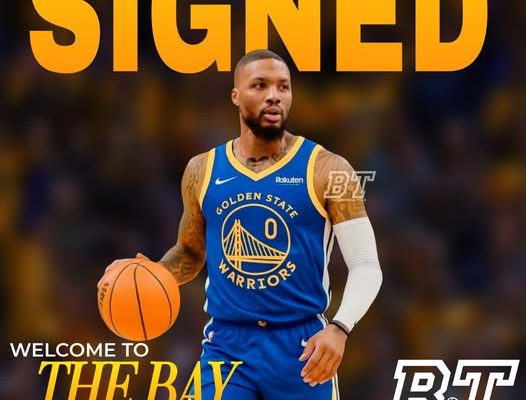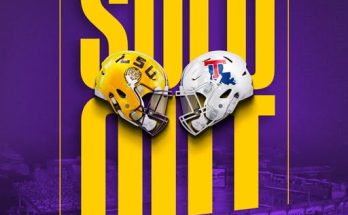The NBA landscape just experienced a seismic shift that is bound to reverberate across the league, sending waves of speculation, excitement, and fear through locker rooms from coast to coast. Damian Lillard, a name synonymous with deep threes, clutch moments, and unwavering loyalty during his tenure with the Portland Trail Blazers, has officially signed a two-year, $51.6 million contract with the Golden State Warriors. This shocking move comes just days after he was waived by the Milwaukee Bucks, following an underwhelming playoff run that fell short of championship aspirations. For many, the idea of Lillard donning a Warriors jersey would’ve seemed laughable a year ago. Today, it is a reality—and one that could change the course of the 2025-26 NBA season and beyond.
The news broke early Thursday morning through Lillard’s agent, and within minutes the NBA universe exploded. From Twitter to ESPN to every sports radio show across the nation, one question dominated: how did this happen? The journey from Milwaukee to San Francisco was abrupt and complicated. After being traded to the Bucks in a blockbuster deal from Portland in 2023, Lillard was seen as the missing piece that would help deliver another championship alongside Giannis Antetokounmpo. But chemistry issues, injuries, and inconsistent performances derailed the Bucks’ title hopes, culminating in a second-round playoff exit. As the Bucks looked to reshape their roster around youth and flexibility, they made the stunning move to waive Lillard, giving him the freedom to choose his next destination.
Few expected that destination to be Golden State. The Warriors, who themselves were licking their wounds from a disappointing season, had long been rumored to be looking for a shakeup. With Klay Thompson departing and the aging core of Stephen Curry and Draymond Green hungry for one last ride, the Warriors found themselves in need of an elite scorer who could fit their system while bringing fresh energy. Enter Damian Lillard, one of the most dynamic offensive weapons in the NBA. The pairing of Curry and Lillard—two of the deadliest shooters in the history of the game—seems almost like a cheat code. But this isn’t just about flashy highlights or headline-grabbing combinations. This is a calculated gamble by both sides, aiming to extract one last championship run before the window closes.
From the Warriors’ perspective, this deal is genius. Lillard’s contract, though hefty at $25.8 million per year, is relatively short term and gives the franchise flexibility beyond the 2026-27 season. The front office, led by Mike Dunleavy Jr., clearly believes that Lillard’s offensive brilliance can be harmonized with Curry’s unselfish playmaking, Andrew Wiggins’ defensive versatility, and Draymond Green’s all-around leadership. More importantly, Lillard brings a sense of urgency. At 35 years old, he’s chasing something that has eluded him his entire career—a championship ring. That hunger is infectious. It’s the kind of motivation that can reignite a dynasty that many believed was finished.
The fit, while promising, does bring challenges. Both Curry and Lillard are primary ball-handlers. Both excel in high pick-and-roll scenarios and off-the-dribble threes. But they are also two of the most intelligent players in the league, with a mutual respect that has been forged through battles on the court and shared experiences off it, including their Team USA time together. Analysts will debate how the Warriors’ motion-heavy offense can accommodate two ball-dominant guards, but Steve Kerr has never been afraid to innovate. In fact, he might relish the chance to coach a backcourt that could redefine offensive strategy in today’s NBA.
For Lillard, the move is about legacy. After years of loyalty to a struggling Portland franchise and a brief, underwhelming stint in Milwaukee, the clock is ticking. Lillard knows he doesn’t have five or six years left at peak performance. This move is about winning now. About rewriting the narrative. About proving that Dame Time still matters when the lights shine the brightest in May and June. His choice of the Warriors, a franchise with a championship pedigree and a core group of proven winners, sends a clear message: he wants the pressure, the spotlight, and the shot at immortality.
The Warriors fan base, still adjusting to the post-Klay era, has responded with a mix of astonishment and excitement. Lillard is not just a player; he is a cultural figure in the basketball world. His loyalty, his toughness, his ability to rise in clutch moments—those are qualities that endear him to fans and teammates alike. In many ways, he mirrors what the Warriors brand has come to represent: resilience, unselfishness, and the pursuit of greatness. Jerseys are already flying off the shelves. Ticket inquiries have spiked. And the buzz around Chase Center is palpable. This isn’t just a roster move—it’s a moment that could define the next era of Warriors basketball.
Of course, this signing doesn’t come without risks. Lillard has battled injuries in recent seasons. His defense, long considered a weak spot, will be tested more than ever in the hyper-switching schemes the Warriors often employ. There will also be natural growing pains as he adjusts to a new offensive system, new teammates, and a new role. Unlike in Portland or Milwaukee, he won’t be the undisputed number one option every night. Sharing the stage with Curry requires humility and trust—two things Lillard has historically demonstrated, but which will now be put to the test in a more competitive environment.
Still, the upside is massive. The thought of Curry and Lillard running two-man actions, spaced by shooters like Wiggins and guided by the defensive brilliance of Green, is tantalizing. The pick-and-roll possibilities are endless. The late-game scenarios—when both guards can hit from anywhere on the court—will give opposing coaches nightmares. Even more important, this move signals that the Warriors are not content to fade quietly into rebuilding mode. They are going all-in.
And what does this mean for the rest of the league? For teams like the Denver Nuggets, Phoenix Suns, and Los Angeles Lakers, the path to a Western Conference title just got a lot more complicated. For young teams like the Minnesota Timberwolves and Oklahoma City Thunder, the Warriors now become a measuring stick again. And for teams in the East, from Boston to Miami, the potential of facing a rejuvenated Warriors team with two Hall of Fame guards leading the charge is a prospect nobody welcomes.
Lillard’s move also adds another intriguing layer to the NBA’s ever-evolving superstar movement. In an era defined by player empowerment and sudden shifts in team dynamics, this deal is both a reminder and a revelation. It reminds us that careers are short, and the window for winning is often brutally small. It also reveals the value of fit, timing, and legacy. Lillard could have chased the biggest payday, but instead chose to pursue meaning. In doing so, he’s carved out a new chapter in his story—one that could end with confetti falling from the rafters.
As the ink dries on the contract and the team prepares for training camp, there is a quiet but growing confidence among the Warriors organization. They’ve been here before—doubted, dismissed, even declared finished. But with Lillard now in the fold, they have the pieces to dream big again. And for Damian Lillard, this may be the ultimate act of reinvention. Not as the face of a franchise, but as the final piece in one of the greatest basketball puzzles ever assembled.
Only time will tell if this bold union delivers the championship that Lillard has chased for over a decade. But one thing is certain—Dame Time has officially arrived in the Bay Area. And the NBA will never be the same again.



